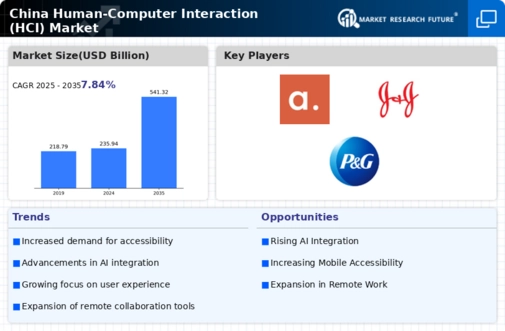Market Growth Projections
The Global China Human-Computer Interaction (HCI) Market Industry is poised for substantial growth, with projections indicating a rise from 235.94 USD Billion in 2024 to 541.32 USD Billion by 2035. This growth trajectory suggests a compound annual growth rate (CAGR) of 7.84% from 2025 to 2035, reflecting the increasing integration of HCI principles across various sectors. The expansion is likely driven by factors such as technological advancements, user-centric design, and the proliferation of smart devices. As organizations continue to invest in HCI solutions, the market is expected to evolve, presenting new opportunities for innovation and development.
Expansion of Smart Devices
The proliferation of smart devices is a significant driver of the Global China Human-Computer Interaction (HCI) Market Industry. With the increasing integration of HCI principles in smartphones, wearables, and IoT devices, users are experiencing more seamless interactions across various platforms. For example, smart home devices utilize voice recognition and gesture control, enhancing user convenience and engagement. This trend is expected to contribute to the market's growth, with a compound annual growth rate (CAGR) of 7.84% projected from 2025 to 2035. As the number of connected devices continues to rise, the demand for effective HCI solutions will likely increase correspondingly.
Rapid Technological Advancements
The Global China Human-Computer Interaction (HCI) Market Industry is experiencing rapid technological advancements that enhance user experience and interface design. Innovations in artificial intelligence, machine learning, and natural language processing are driving the development of more intuitive systems. For instance, AI-driven chatbots and virtual assistants are becoming commonplace in various sectors, improving customer interaction and satisfaction. This technological evolution is projected to contribute significantly to the market's growth, with the industry expected to reach 235.94 USD Billion in 2024. As these technologies continue to evolve, they are likely to reshape user expectations and interactions with digital platforms.
Rising Awareness of Accessibility
The increasing awareness of accessibility issues is significantly influencing the Global China Human-Computer Interaction (HCI) Market Industry. Organizations are recognizing the importance of designing products that are inclusive and accessible to all users, including those with disabilities. This shift is prompting the adoption of HCI practices that prioritize accessibility features, such as screen readers and alternative input methods. As companies strive to comply with regulations and meet user expectations, the demand for accessible design is likely to grow. This trend not only enhances user satisfaction but also expands market opportunities, contributing to the overall growth of the industry.
Government Initiatives and Support
Government initiatives aimed at promoting digital transformation are playing a crucial role in the Global China Human-Computer Interaction (HCI) Market Industry. Policies that encourage innovation and investment in technology are fostering an environment conducive to HCI development. For instance, various government programs are providing funding and resources for research and development in HCI technologies. This support is likely to stimulate growth within the industry, as it enables companies to explore new solutions and improve existing products. As a result, the market is expected to witness substantial growth, aligning with the broader goals of enhancing digital infrastructure and user engagement.
Increasing Demand for User-Centric Design
There is a growing emphasis on user-centric design within the Global China Human-Computer Interaction (HCI) Market Industry. Organizations are increasingly recognizing the importance of tailoring products to meet the specific needs and preferences of users. This shift is evidenced by the rise of user experience (UX) research and design methodologies that prioritize user feedback and usability testing. As companies strive to create more engaging and accessible interfaces, the demand for skilled HCI professionals is likely to surge. This trend aligns with the projected market growth, as the industry is anticipated to expand to 541.32 USD Billion by 2035, reflecting the value placed on user experience.




